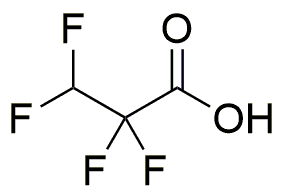2,2,3,3-Tetrafluoropropionic acid is widely utilized in research focused on:
- Fluorinated Polymer Production: This compound serves as a precursor in the synthesis of fluorinated polymers, which are known for their chemical resistance and thermal stability. These polymers find applications in coatings, adhesives, and sealants.
- Pharmaceutical Development: It is used in the synthesis of various pharmaceutical intermediates, enhancing the efficacy and stability of drug formulations, particularly in the development of fluorinated compounds that can improve bioavailability.
- Analytical Chemistry: The compound is employed as a reagent in analytical methods, such as NMR spectroscopy, to improve the resolution and sensitivity of chemical analyses, making it valuable in both academic and industrial laboratories.
- Environmental Studies: It plays a role in studying the behavior of fluorinated compounds in the environment, aiding researchers in understanding their impact and degradation pathways, which is critical for regulatory compliance and environmental protection.
- Surface Modification: This chemical is used to modify surfaces to enhance hydrophobicity and chemical resistance, which is beneficial in industries like electronics and textiles, where durability and performance are paramount.
General Information
Properties
Safety and Regulations
Applications
2,2,3,3-Tetrafluoropropionic acid is widely utilized in research focused on:
- Fluorinated Polymer Production: This compound serves as a precursor in the synthesis of fluorinated polymers, which are known for their chemical resistance and thermal stability. These polymers find applications in coatings, adhesives, and sealants.
- Pharmaceutical Development: It is used in the synthesis of various pharmaceutical intermediates, enhancing the efficacy and stability of drug formulations, particularly in the development of fluorinated compounds that can improve bioavailability.
- Analytical Chemistry: The compound is employed as a reagent in analytical methods, such as NMR spectroscopy, to improve the resolution and sensitivity of chemical analyses, making it valuable in both academic and industrial laboratories.
- Environmental Studies: It plays a role in studying the behavior of fluorinated compounds in the environment, aiding researchers in understanding their impact and degradation pathways, which is critical for regulatory compliance and environmental protection.
- Surface Modification: This chemical is used to modify surfaces to enhance hydrophobicity and chemical resistance, which is beneficial in industries like electronics and textiles, where durability and performance are paramount.
Documents
Safety Data Sheets (SDS)
The SDS provides comprehensive safety information on handling, storage, and disposal of the product.
Product Specification (PS)
The PS provides a comprehensive breakdown of the product’s properties, including chemical composition, physical state, purity, and storage requirements. It also details acceptable quality ranges and the product's intended applications.
Certificates of Analysis (COA)
Search for Certificates of Analysis (COA) by entering the products Lot Number. Lot and Batch Numbers can be found on a product’s label following the words ‘Lot’ or ‘Batch’.
*Catalog Number
*Lot Number
Certificates Of Origin (COO)
This COO confirms the country where the product was manufactured, and also details the materials and components used in it and whether it is derived from natural, synthetic, or other specific sources. This certificate may be required for customs, trade, and regulatory compliance.
*Catalog Number
*Lot Number
Safety Data Sheets (SDS)
The SDS provides comprehensive safety information on handling, storage, and disposal of the product.
DownloadProduct Specification (PS)
The PS provides a comprehensive breakdown of the product’s properties, including chemical composition, physical state, purity, and storage requirements. It also details acceptable quality ranges and the product's intended applications.
DownloadCertificates of Analysis (COA)
Search for Certificates of Analysis (COA) by entering the products Lot Number. Lot and Batch Numbers can be found on a product’s label following the words ‘Lot’ or ‘Batch’.
*Catalog Number
*Lot Number
Certificates Of Origin (COO)
This COO confirms the country where the product was manufactured, and also details the materials and components used in it and whether it is derived from natural, synthetic, or other specific sources. This certificate may be required for customs, trade, and regulatory compliance.


